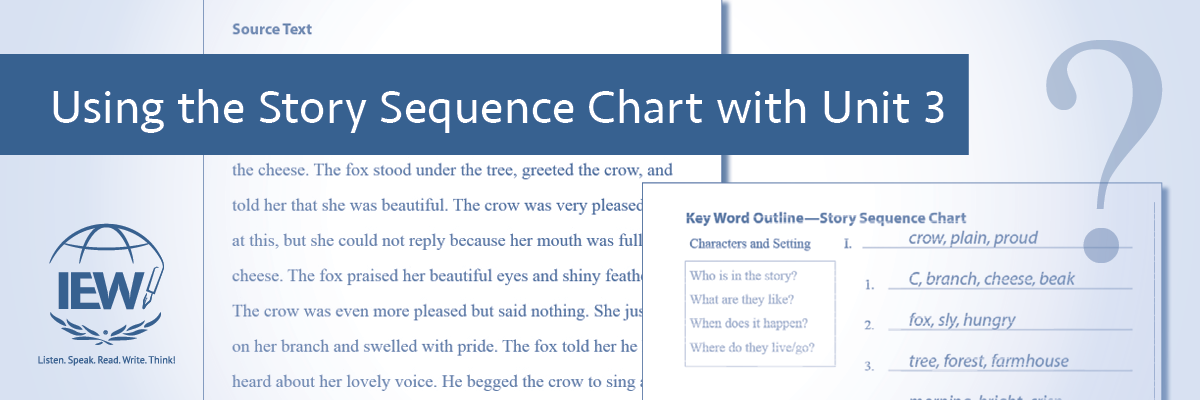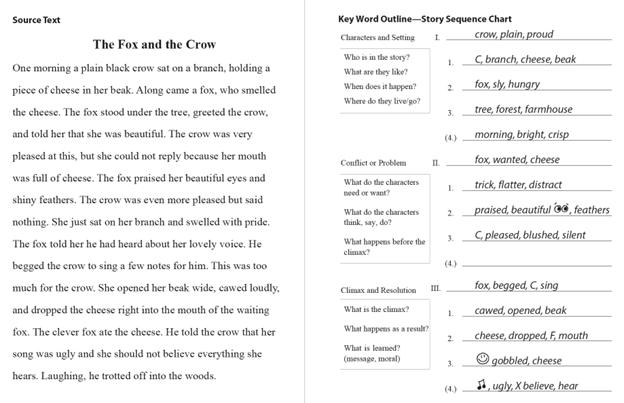
IEW teaches students to write with structure and with style. Style includes vocabulary. Structure is the elements found in compositions. Throughout the year students progress through nine structural units.
After three to four weeks of taking notes with Unit 1 and then writing the paper with Unit 2, advance to Unit 3: Retelling Narrative Stories. In this unit students summarize a narrative story in three paragraphs. In the process they learn how to ask questions and articulate their thoughts, and they discover that every paragraph has a defined purpose.
As students learned in Unit 1, writing begins with the key word outline. The rules for writing the key word outline (KWO) remain: write 2-3 key words on each line and use symbols, numbers, and abbreviations when applicable. In Unit 1 students write their KWO by taking notes from the text, sentence by sentence. In Unit 3 students write their KWO as they answer questions listed on the Story Sequence Chart.
Asking questions and providing answers is the first step in creative writing. The bulk of the information for the KWO will not be found by looking in the text but by looking in the mind. Begin with a story of any length: a one-paragraph fable, a short story, a novel, or a movie. The basic components will be there.
Characters and Setting
The characters are the who of the story. The setting is the when and where. Even if a story opens with a fast car chase or action scene, there are still characters, and they are some place at some time.
Conflict or Problem
The conflict or problem is created when the main character needs or wants something. In every story the main character overcomes some sort of problem. Stories without problems are boring. In fact, they are really not stories at all.
Climax and Resolution
The climax is the exciting moment or event when the story changes. It is the turning point in the story when the problem is solved one way or the other. The resolution follows. As students focus on the last portion of the story, they must consider if the problem is solved the way the character wants and what lesson the author intends to convey.
After reading and discussing the story, ask students the questions listed on the Story Sequence Chart. This chart provides a framework to help students organize their thoughts. By asking questions, students learn to think and to articulate their thoughts. As students answer the questions, they should use key words to note the information on the outline.
This should be a fun activity. Students do not have to answer every question. If they do not readily know an answer, allow them to make up information. The answers can be brief. After all, students may add details when they write their own versions of the story. This sample source text and KWO are from Adventures in Writing.

Because IEW teaches with spiral learning, students revisit Unit 3 yearly. While younger students and those new to IEW should begin with a straight summary, older more seasoned students may elaborate by adding details to various portions of the story. In time, suggest that students write a variation of the story by changing the characters and setting. For example, instead of writing about “The Boy Who Cried Wolf,” they may write about “The Astronaut Who Cried Alien.” Older more established writers may write a sequel to the story by keeping the characters and setting but changing the problem. Challenge skilled high school students to rewrite a story as a poem or even a skit.
The questions listed on the Story Sequence Chart encourage students to expand their creativity through imitation and variation. The five basic elements of the Story Sequence Chart train students to organize their thoughts as they analyze literature. By the time the school year nears its conclusion, students will revisit this chart to critique books and movies, further appreciating the genius of the Story Sequence Chart.
by Heidi Thomas
Originally posted on November 17, 2023
